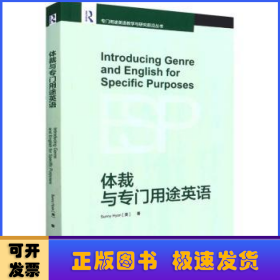
体裁与专门用途英语(专门用途英语教学与研究前沿丛书)
全新正版 极速发货
¥ 43.66 6.8折 ¥ 63.9 全新
库存6件
广东广州
认证卖家担保交易快速发货售后保障
作者(美)桑妮·伊翁
出版社外语教学与研究出版社
ISBN9787521332087
出版时间2022-02
装帧平装
开本16开
定价63.9元
货号1202614610
上书时间2024-06-01
- 最新上架
商品详情
- 品相描述:全新
- 商品描述
-
目录
总序
导读
Acknowledgements
Part Ⅰ Introduction
Chapter 1 Introducing genre in English for Specific Purposes
1 What is a genre?
2 Why genre in ESP?
3 Early genre work
4 Preview of the rest of this book
Part Ⅱ ESP genre analysis
Chapter 2 Analyzing genre moves
1 What are moves?
2 How to do a moves analysis
3 Seeking input from specialist informants
4 Cross-cultural moves comparisons
5 Using and revising existing move models
6 Tying it all together: analyzing moves in a TED Talk
Chapter 3 Analyzing lexicogrammatical features
1 Methods of lexicogrammatical analysis
2 Some concordance lines for significant in critique genres in BAWE
3 Studying linguistic politeness in genres
4 Cross-cultural lexicogrammatical comparisons
5 Connecting moves and lexicogrammatical analysis
Chapter 4 Analyzing genre contexts
1 The value of analyzing genre contexts
2 How to study genre contexts
3 Gaining access to a context
4 Critical ethnography
Part Ⅲ ESP genre-based learning and teaching
Chapter 5 Designing genre-based courses
1 The role of instruction in genre learning
2 Needs and rights analysis
3 How to do a needs analysis for a genre-based course
4 From needs analysis to course design
5 Four genre-based course designs
Chapter 6 Creating and assessing genre-based teaching materials
1 Genre-based tasks
2 Sequencing genre-based activities
3 Text selection
4 Assessing the impact of course materials
Chapter 7 Exploring future issues: genre play, learning, and transfer
1 What is genre play and why study it?
2 Forms of genre play
3 What makes genre play work?
4 Possibilities for future genre play research
5 What is genre learning transfer and why study it?
6 Current observations of genre learning transfer
7 Possibilities for future genre learning transfer research
References
Index
内容摘要
《体裁与专门用途英语》一书主要梳理、阐述和探讨了专门用途英语语境下的体裁相关话题,为如何结合体裁理论有效开展专门用途英语教学,提升学习者的体裁意识和体裁能力提供了切实可行的方案。全书分为三大部分,共七章。第一部分梳理了专门用途英语语境下的体裁概念构架、体裁理论发展;第二部分阐述了专门用途英语语境下体裁分析的具体视角和路径;第三部分探讨了专门用途英语语境下体裁教学的课程设计、教学材料的建设与评估,以及未来发展的方向。此外,作者独具匠心,专门在每一章设计了教学实践任务。
相关推荐
— 没有更多了 —






















以下为对购买帮助不大的评价